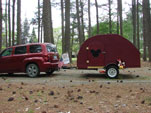Another approach is to build your own "mini-SIPS" variation
on the Foamie method. This is probably the approach I'll take
whenever I get to it. One reason for this is, I do want a Birch
plywood interior - they're just too pretty to ignore for me.
Another reason is for some ease in building - something you do
need to consider among all the other variables.
Here's a repost of some info I did on SIPs for another thread
somewhere else on here, that I'm too pooped to look up at the
moment, so I'll just paste it in again here:
**********
I think SIPs are a good idea and I will probably use a form of them
whenever I get to build. [Too many house projects are a priority
at the moment.] For a larger size construction, I'd seriously look
into them. I consider them a Foamie variation.
Anyway, check out linuxmanxxx's post/builds.
Here's the link to them:
search.php?st=0&sk=t&sd=d&sr=posts&author_id=11546He is using a small scale version of them and gives details on how he did them -
they'll be a reference for me in the future. He uses them in his business:
http://www.microcampers.com/ Just browse through them until you reach one
that pertains to his SIPs and then click on the thrtead title if you need context.
Here are some links to a SIP builder with a differance. [compared to those
SIPs that are used for house construction.] They are in Washington State,
and make many different kinds/thicknesses of them. Quite an interesting product.
http://www.superhoneycomb.com/http://singcore.com/http://singcore.com/tiny_index.htmlhttp://media.designerpages.com/3rings/2 ... ing-homes/You should be quite interested in the following:
A gal in Washington State is building a tenwide Tiny House, using them:
http://mytinyabode.blogspot.com/And her Dad is using them to remodel a vintage Airfloat TT:
http://www.everyonecandance.com/Airfloat_Process.html**********
To make your build usable you need to include all sorts of things
that you may require, and the easiest way to include attachment/
hard points for those, in my view, is this Mini-SIP approach.
I've also been wondering about a variation on the Mini-SIP that'd use
the stitch-n-glue boat building method.
http://www.boatbuilder.org/With that I'd basically build the inside walls of 1/4in plywood with the S-n-G
method, frame any/the openings' perimeters and the outside edges
with the appropriate size 1x wood or such, and then glue in the foam
[most likely in the appropriate shaped/sized pieces vs a large sheet]
to cover the outside of the interior 1/4in plywood walls and thus help
insulate [an uninsulated trailer is a poor accomodation in my personal
view] and fill out the form of the body of the trailer. Any seams and gaps
would be minimized while applying the foam pieces, but any remaining gaps
can be filled in with one of the canned gap-filling foams, and then all
that'd be smoothed out and then faired out with some kind of fillers to
try and make a smooth surface for the outside skin. After that, I'd probably
go with either a fabric and glue and paint or fiberglass cloth and epoxy
as the outside skin. It all depends on costs and if I could even tolerate
the fiberglassing fumes. [Epoxy is supposedly less "fumey" than the
polyester type, but I do have allergy problems with some chemicals,
so that'd remain to be seen if that could even be a possibility.] Some
kind of foamcoat is another alternative too, but they are more expensive
than the old-time fabric-glue-paint method.
Cheers,
Norm/mezmo
If you have a house - you have a hobby.






 )
)

 Foam board from the Wally World is 1/4” thick , so would make an ideal 1/8 scale model of a 2” foam trailer build ... and it’s already paper skinned on each side ... very Easy to work with ...
Foam board from the Wally World is 1/4” thick , so would make an ideal 1/8 scale model of a 2” foam trailer build ... and it’s already paper skinned on each side ... very Easy to work with ...